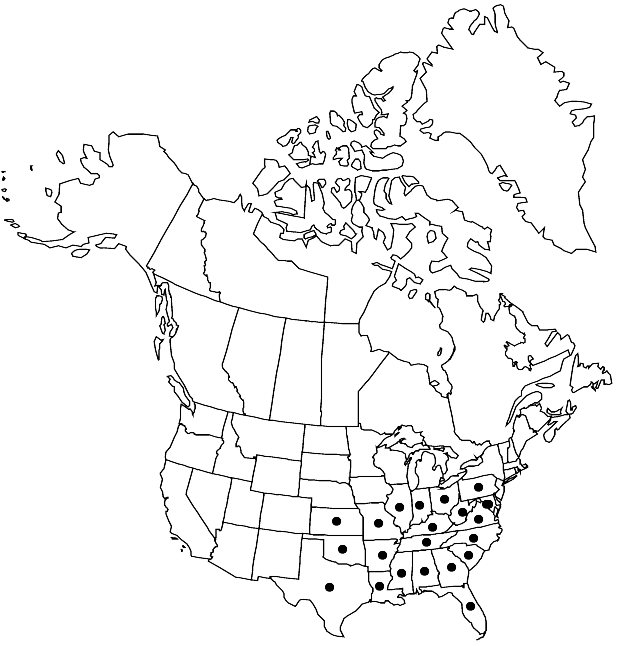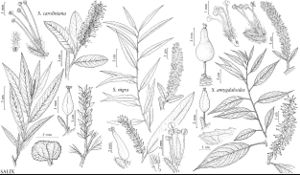Difference between revisions of "Salix caroliniana"
Fl. Bor.-Amer. 2: 226. 1803.
FNA>Volume Importer |
imported>Volume Importer |
||
| (6 intermediate revisions by 2 users not shown) | |||
| Line 8: | Line 8: | ||
}} | }} | ||
|common_names=Carolina or coastal plain willow | |common_names=Carolina or coastal plain willow | ||
| + | |special_status={{Treatment/ID/Special_status | ||
| + | |code=W | ||
| + | |label=Weedy | ||
| + | }}{{Treatment/ID/Special_status | ||
| + | |code=F | ||
| + | |label=Illustrated | ||
| + | }} | ||
|basionyms= | |basionyms= | ||
|synonyms={{Treatment/ID/Synonym | |synonyms={{Treatment/ID/Synonym | ||
|name=Salix longipes var. venulosa | |name=Salix longipes var. venulosa | ||
|authority=(Andersson) C. K. Schneider | |authority=(Andersson) C. K. Schneider | ||
| − | }}{{Treatment/ID/Synonym | + | |rank=variety |
| + | }} {{Treatment/ID/Synonym | ||
|name=Salix longipes var. wardii | |name=Salix longipes var. wardii | ||
|authority=(Bebb) C. K. Schneider | |authority=(Bebb) C. K. Schneider | ||
| + | |rank=variety | ||
}} | }} | ||
|hierarchy=Salicaceae;Salix;Salix subg. Protitea;Salix sect. Humboldtianae;Salix caroliniana | |hierarchy=Salicaceae;Salix;Salix subg. Protitea;Salix sect. Humboldtianae;Salix caroliniana | ||
| Line 31: | Line 40: | ||
|distribution=Ala.;Ark.;D.C.;Fla.;Ga.;Ill.;Ind.;Kans.;Ky.;La.;Md.;Miss.;Mo.;N.C.;Ohio;Okla.;Pa.;S.C.;Tenn.;Tex.;Va.;W.Va.;Mexico (Nuevo León);West Indies (Cuba);Central America (Guatemala). | |distribution=Ala.;Ark.;D.C.;Fla.;Ga.;Ill.;Ind.;Kans.;Ky.;La.;Md.;Miss.;Mo.;N.C.;Ohio;Okla.;Pa.;S.C.;Tenn.;Tex.;Va.;W.Va.;Mexico (Nuevo León);West Indies (Cuba);Central America (Guatemala). | ||
|discussion=<p>Hybrids:</p><!-- | |discussion=<p>Hybrids:</p><!-- | ||
| − | --><p>Salix caroliniana forms natural hybrids with S. nigra. Hybrids with S. amygdaloides have been reported (N. M. Glatfelter 1898); no convincing specimens have been seen.</p><!-- | + | --><p><i>Salix caroliniana</i> forms natural hybrids with <i>S. nigra</i>. Hybrids with <i>S. amygdaloides</i> have been reported (N. M. Glatfelter 1898); no convincing specimens have been seen.</p><!-- |
| − | --><p>Salix caroliniana × S. nigra: This hybrid is characterized by stipes to 1.3 mm and leaves glaucous; it probably occurs wherever the two parents come into contact. In the southeastern United States, it occurs from northern Florida to West Virginia and Maryland with intergradation mainly on the Atlantic coastal plain from northern Florida and southern Georgia (G. W. Argus 1986). Reports (N. M. Glatfelter 1898) of it from the vicinity of St. Louis, Missouri, are unconfirmed.</p> | + | --><p><i>Salix caroliniana</i> × <i>S. nigra</i>: This hybrid is characterized by stipes to 1.3 mm and leaves glaucous; it probably occurs wherever the two parents come into contact. In the southeastern United States, it occurs from northern Florida to West Virginia and Maryland with intergradation mainly on the Atlantic coastal plain from northern Florida and southern Georgia (G. W. Argus 1986). Reports (N. M. Glatfelter 1898) of it from the vicinity of St. Louis, Missouri, are unconfirmed.</p> |
|tables= | |tables= | ||
|references= | |references= | ||
| Line 41: | Line 50: | ||
-->{{#Taxon: | -->{{#Taxon: | ||
name=Salix caroliniana | name=Salix caroliniana | ||
| − | |||
|authority=Michaux | |authority=Michaux | ||
|rank=species | |rank=species | ||
| Line 55: | Line 63: | ||
|publication title=Fl. Bor.-Amer. | |publication title=Fl. Bor.-Amer. | ||
|publication year=1803 | |publication year=1803 | ||
| − | |special status= | + | |special status=Weedy;Illustrated |
| − | |source xml=https:// | + | |source xml=https://bitbucket.org/aafc-mbb/fna-data-curation/src/2e0870ddd59836b60bcf96646a41e87ea5a5943a/coarse_grained_fna_xml/V7/V7_23.xml |
|genus=Salix | |genus=Salix | ||
|subgenus=Salix subg. Protitea | |subgenus=Salix subg. Protitea | ||
Latest revision as of 22:32, 5 November 2020
Trees, 5–10 m. Stems: branches ± brittle at base, gray-brown to red-brown, glabrous, villous, or tomentose; branchlets yellow-brown to red-brown, glabrous, sparsely or densely villous or tomentose. Leaves: stipules rudimentary or foliaceous on early ones, foliaceous on late ones, apex convex to acute; petiole (with spherical glands distally), (3–)4.5–14(–22) mm, tomentose or pilose adaxially; largest medial blade lorate or lanceolate to narrowly lanceolate, (50–)75–115(–220) × 10–22(–35) mm, 5–10 times as long as wide, base usually convex or cuneate, sometimes rounded to cordate, margins serrate or serrulate, apex acuminate, acute, or caudate, abaxial surface glabrous or sparsely tomentose on midribs, hairs white and/or ferruginous, wavy, adaxial highly glossy, glabrous or pilose, hairs white and/or ferruginous; proximal blade margins entire or serrulate; juvenile blade glabrous, or moderately densely tomentose or silky abaxially, hairs white and ferruginous. Catkins: staminate 28–97 × 5–11 mm, flowering branchlet 4–25 mm; pistillate 33–93 × 7–15 mm, flowering branchlet 3–35 mm; floral bract 1–3 mm, apex acute or rounded, entire or erose, abaxially sparsely hairy, hairs wavy; pistillate bract deciduous after flowering. Staminate flowers: abaxial nectary 0.3–0.5 mm, adaxial nectary oblong to narrowly oblong, 0.3–0.6 mm, nectaries distinct; stamens 4–7; filaments (sometimes connate less than 1/2 their lengths), hairy basally; anthers 0.4–0.6 mm. Pistillate flowers: adaxial nectary oblong, square, or ovate, 0.3–0.7 mm; stipe 1.3–5.3 mm; ovary pyriform to obclavate, beak slightly bulged below styles; ovules 12–16 per ovary; styles (sometimes distinct distally), 0.1–0.2 mm; stigmas 0.16–0.2–0.28 mm. Capsules 4–6 mm.
Phenology: Flowering (south) Dec-early May, (north) mid Apr-early Jun.
Habitat: Alluvial woods on floodplains, swamps, hummocks, marshes, wet interdunal depressions, rocky or gravelly streambeds, ditches, canals, usually on calcareous substrates
Elevation: 0-600 m
Distribution

Ala., Ark., D.C., Fla., Ga., Ill., Ind., Kans., Ky., La., Md., Miss., Mo., N.C., Ohio, Okla., Pa., S.C., Tenn., Tex., Va., W.Va., Mexico (Nuevo León), West Indies (Cuba), Central America (Guatemala).
Discussion
Hybrids:
Salix caroliniana forms natural hybrids with S. nigra. Hybrids with S. amygdaloides have been reported (N. M. Glatfelter 1898); no convincing specimens have been seen.
Salix caroliniana × S. nigra: This hybrid is characterized by stipes to 1.3 mm and leaves glaucous; it probably occurs wherever the two parents come into contact. In the southeastern United States, it occurs from northern Florida to West Virginia and Maryland with intergradation mainly on the Atlantic coastal plain from northern Florida and southern Georgia (G. W. Argus 1986). Reports (N. M. Glatfelter 1898) of it from the vicinity of St. Louis, Missouri, are unconfirmed.
Selected References
None.
